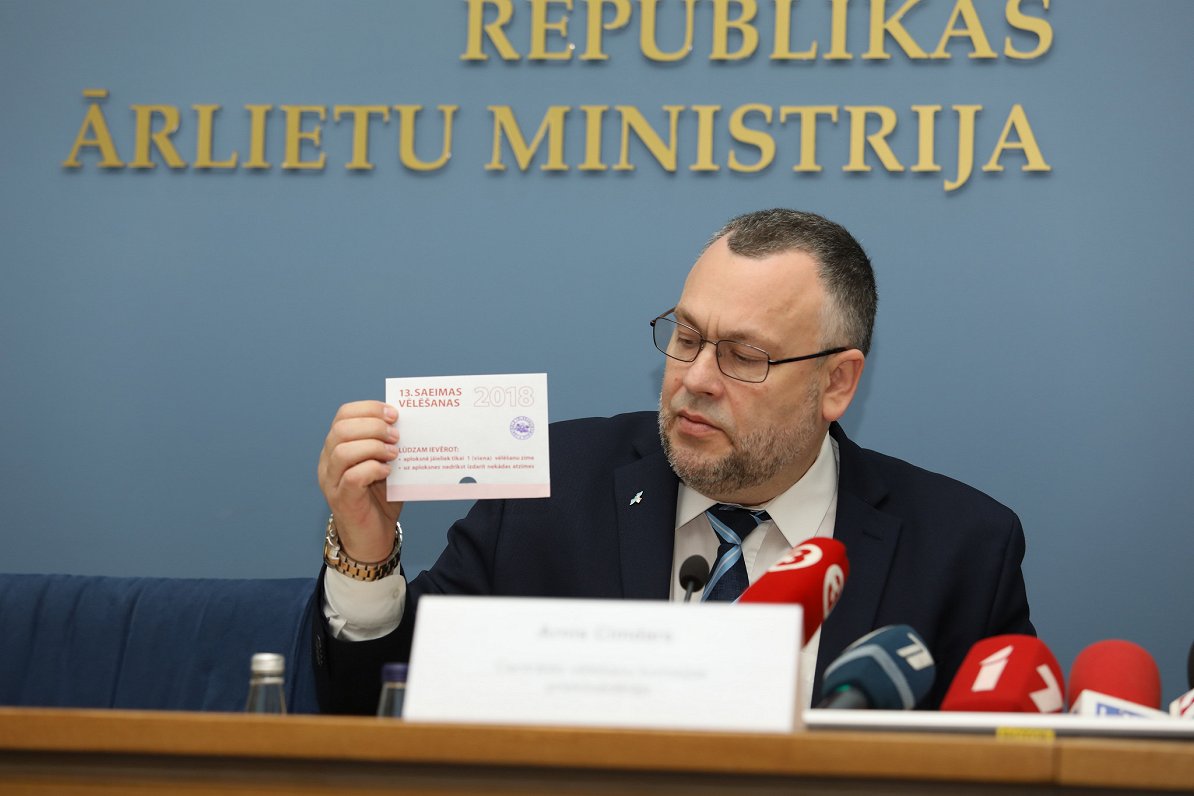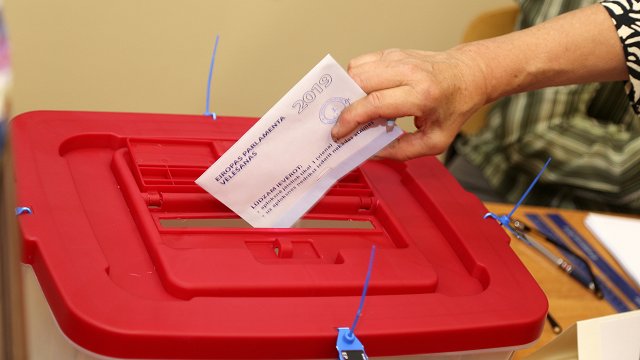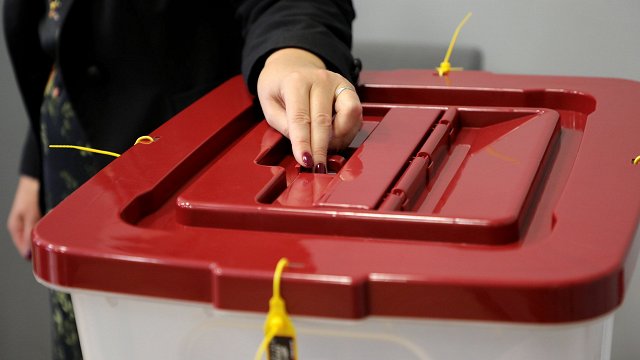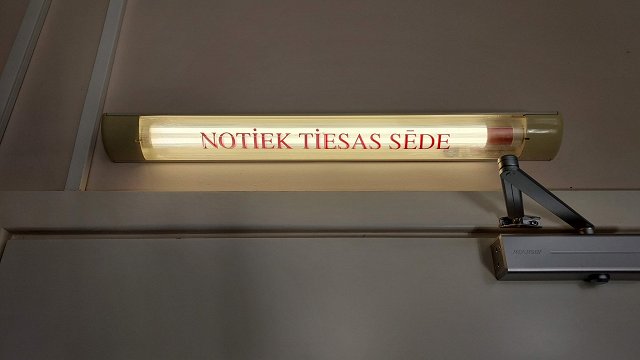CANDIDATES
Candidates for Saeima elections must be members of a registered political party or alliance of parties. For the 13th Saeima elections, parties had from 18 July to 7 August to submit their candidate lists to the Central Election Commission (CVK), the body which oversees all elections in the country.
Candidates have to be Latvian citizens (dual citizens are also eligible) aged 21 or over. There are certain restrictions on allowing former Communist party members, Soviet functionaries, prisoners and mentally ill persons to stand.
Parties have to make a security deposit of €1400 along with the submission of their electoral list. The list must be submitted both electronically and in paper form. If the party fails to win at least 2% of the vote, it loses its deposit.
Parties can field a maximum of 115 candidates. The numbers of the parties on the ballot paper are drawn by lot to ensure they are random.
For the 13th Saeima elections a total of 1461 candidates are registered with 16 party lists. The number was slightly reduced after a handful of candidates were ruled ineligible after CVK checks.
For the 2018 election, 68% of candidates are male and 32 percent female. This represents a greater slightly greater imbalance than the last elections in 2014 when 67% of candidates were male and 33% female.
The average age of candidates is 46.5 years.
VOTING RIGHTS
All citizens of Latvia aged 18 and over are entitled to vote on election day. They need to take their passports with them to vote and receive a special stamp in it to confirm that they have voted.
Latvia's "non-citizens" - a legacy of the Soviet occupation years - are not entitled to vote in parliamentary elections, even if they have permanent resident status. However, they can gain the right to vote if they undergo a process of naturalization and become citizens.
For the 13th Saeima elections, electronic identity cards (eIDs) can also be used to vote at polling stations, provided holders of the cards have applied in advance for a special document allowing them to do so. This measure applies to a few thousand citizens who have eIDs but not passports.
Latvia does not currently offer electronic voting (e-voting) as is the practice in neighboring Estonia.
CONSTITUENCIES
Latvia operates a proportional representation system during elections. Nevertheless, the country is divided into five separate constituencies and the number of seats available in each constituency is based upon the number of registered voters each one contains. The growth of Rīga in recent years has seen it gain more and more seats so that for 2018 the distribution will be as follows: Rīga (35 seats), Vidzeme (25 seats), Latgale (14 seats), Zemgale (14 seats) and Kurzeme (12 seats).
For comparison purposes, the distribution in 2014 was: Riga (32 seats), Vidzeme (26 seats), Latgale (15 seats), Kurzeme (13 seats), and Zemgale (14 seats). Back in the 5th Saeima elections of 1990, Rīga had just 24 seats.
Candidates must choose one of the constituencies only in which to stand.
The total size of the electorate is 1.54 million of Latvia's roughly 2 million population.
CAMPAIGNING
The period of pre-election campaign lasts from 120 days before the elections until the election day.
From the 30th day before the election day the placement of materials of pre-election campaign on television is prohibited.
On election day, and the day before election day, the placement of materials of pre-election campaigns on radio, public outdoor areas and indoor premises, publications, on the Internet and authorities and capital companies, in which more than 50 per cent of capital shares (stocks) belong to the State or a municipality, is prohibited.
On the Internet (except for the website of the political parties and alliances of political parties) on Election Day and the day before the Election Day, paid pre-election campaign also is prohibited.
On election day when polling stations are open campaigning is prohibited inside the polling station or within 50 meters from the entrance to the building in which the polling station is located.
Monitoring of pre-election campaign is carried out (depending on the type of campaign) by the Corruption Prevention and Combating Bureau, the National Electronic Mass Media Council, the State Police and the Municipal Police.
ELECTION DAY
On election day, October 6, 954 polling stations in Latvia will be open between 7 am and 8 pm.
At selected polling stations, voters will be able to take part in "early voting" from October 3 where their ballots will be kept securely then added to the main count on October 6.
Voters unable to come to the polling station for health reasons can apply in advance for "off-site" voting which involves an election official visiting them to receive the ballot.
Special arrangements are also made for military personnel serving overseas and for prisoners who retain the right to vote.
OVERSEAS VOTING
121 polling stations will be open in countries outside Latvia, usually located at Latvia's diplomatic representations. 21 polling stations will be in the United States and 19 in the United Kingdom. A map of all polling stations worldwide is available, which also includes polling stations in the United Arab Emirates, Australia, Austria, Azerbaijan, Belarus, Belgium, Brazil, the Czech Republic, Denmark, Egypt, France, Greece, Georgia, Estonia, India, Iceland, Italy, Israel, Ireland, Japan, New Zealand, Canada, Kazakhstan, Korea, Russia, China, Lithuania, Luxembourg, Mexico, Moldova, the Netherlands, Norway, Poland, Portugal, Finland, Spain, Switzerland, Turkey, Ukraine, Hungary, Uzbekistan, Germany and Sweden.
Advance postal votes were also available to people living overseas unable to make their way to a polling station. Applications for voting by mail had be submitted in advance between the 5th of May and the 14th of September to any of diplomatic or consular missions of Latvia that organizes postal voting.
Polling stations abroad are included as part of the Riga constituency, therefore voters abroad may only vote for the lists of candidates registered in the Riga constituency.
Voters usually residing abroad, but who will be in Latvia on the election day, may vote at any polling station in Latvia. A special mark is made in passports to certify the participation in election, so these voters may not vote twice.
VOTING
After having their identity confirmed at a polling station, each voter is issued with a complete set of ballot papers containing all the candidates nominated for the constituency and a ballot envelope bearing the stamp of the relevant polling station commission - quite a bundle of paper, in fact.
The voter chooses the party for which he or she wishes to vote.
In an unusual feature of Latvian elections, a voter does not necessarily have to mark a ballot paper at all - the list can be put in a sealed envelope and deposited in the ballot box and the vote is recorded for the party when the count takes place.
Alternatively, the voter may choose to put a “+” mark opposite the name of a candidate or candidates they particularly like on the party list and/or cross out the names of any candidates they don't like. This process effectively moves candidates "up" or "down" the party list, though of course it still only counts as one vote for one party.
Either way the voter inserts the ballot paper containing the list of candidates for which he or she has chosen to vote into the envelope (in a private voting booth), and emerges to put the envelope into the public ballot box.
RESULTS
The vote count starts as soon as the polls close.
Parties winning at least 5% of the total vote will win at least one seat in parliament. The exact distribution of seats is determined by a fairly complex formula dependent upon how many parties cross the 5% threshold.
Provisional results are published as they come in on the CVK's dedicated website. Usually by 3 or 4 a.m. about half of the results will be in, with the vast majority in by 6 a.m. An announcement of provisional results is usually made the day after the vote with the final results officially confirmed a week later. The CVK dictates the date of the first sitting of the new Saeima.
And with that all done, another process entirely begins as the parties elected size each other up and think about the shape of the next government after the President nominates one party leader to try to form a government. The President may choose whoever he or she thinks has the best chance of forming a viable administration - not necessarily the leader of the party that won the most seats...




































